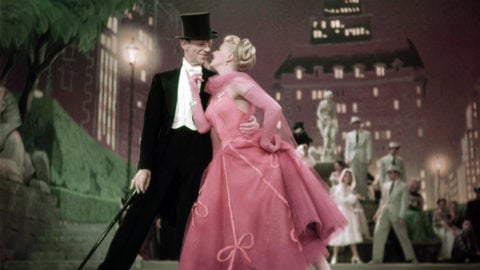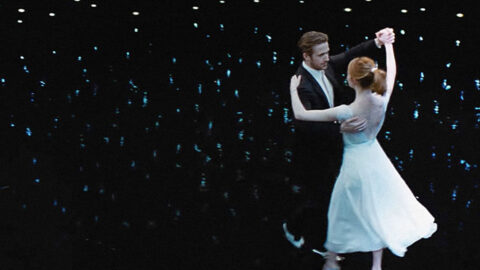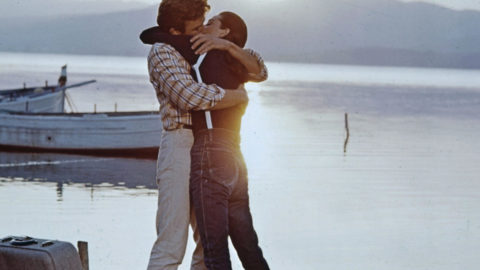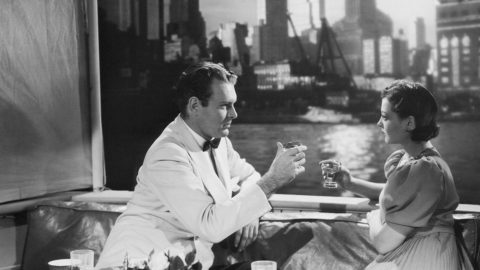Always Gonna Dance
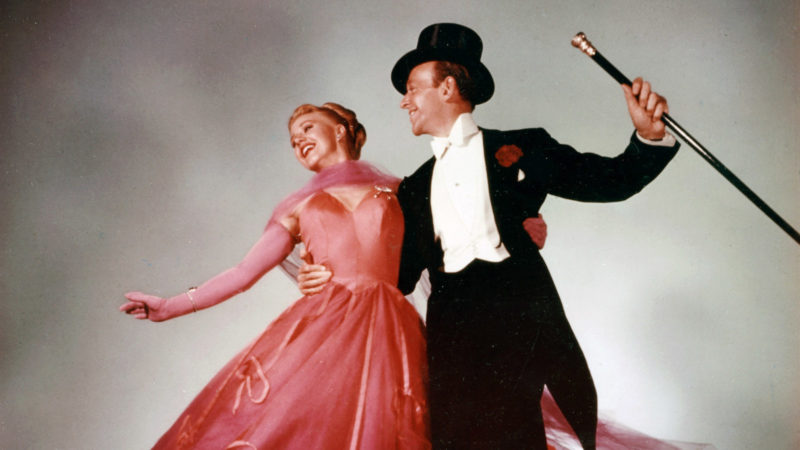
The Barkleys of Broadway
This article originally appeared in the September-October 1979 issue of Film Comment.
Confessional
My interest in the cinema started when I saw Top Hat at the age of five; from then on I saw all the Astaire-Rogers movies as they came out. This, then, is a belated tribute to Fred and Ginger, without whom I might never have been where I am today (wherever that is). Inevitably—over forty years having passed since that first magical encounter—the tribute will not be without its ambivalence. If they contributed so much to my delight, it is clear in retrospect that they also contributed, as “myth,” to my oppression.
Factual
Anyone wanting detailed information about the Astaire-Rogers films should go to Arlene Croce’s admirably scholarly work, The Fred Astaire and Ginger Rogers Book. I borrow here simply enough to establish, as a starting point, a sense of the films as concoctions, fabricated according to strict formulas, taking on something of the character of ritual.
Between 1933 and 1939, Astaire and Rogers made nine films together for RKO (with a postscript ten years later in their comeback, The Barkleys of Broadway, made for MGM). However personal to Astaire the dances may be, the films are clearly the products of a team; and it doesn’t matter that the team did not remain constant.
Directors: Five of the nine were directed by Mark Sandrich, for whom no one (to my knowledge) has ever claimed auteur status. Swing Time was directed by George Stevens (who also directed Damsel in Distress, Astaire’s only film without Rogers during this period). Most aficionados claim Swing Time as the best of the nine, with Top Hat as chief competitor. I don’t think too much should be made of the fact that it’s the only one with a director who distinguished himself elsewhere: it can’t be argued that Swing Time is a “personal” work for Stevens, any more than Duck Soup is for Leo McCarey. One might suggest that the presence of a “strong” director helped pull everything together, but no more.
Music: Three of the films (Top Hat, Follow the Fleet, Carefree) have scores by Irving Berlin; two have scores by Jerome Kern (Roberta, Swing Time); Shall We Dance has a Gershwin score (as does Damsel in Distress).
Scripts: Dwight Taylor worked on three of the films, Allan Scott on six; they combined for Top Hat and Follow the Fleet, where the basic, formulaic plot patterns become definitive; Scott and Howard Lindsay wrote Swing Time.
Dances: Hermes Pan is (apart from the two stars) the most consistent figure through the series, usually with some such credit as “Ensembles staged by….” He and Astaire collaborated on the solos and duets, Astaire being largely his own choreographer; according to Croce, the crucial aesthetic decision to shoot each Astaire-Rogers number whenever possible in a single unbroken take was Astaire’s.
Social Background
Crucially, the Depression, with its concomitant demand for “escapist entertainment”—though whether it is a question of demand (“Distract us”) or imposition (“Distract them!”) is of course highly debatable. The films manifest two strategies for dealing with this. 1: Fred and Ginger are above any financial hardship, inhabiting a pure escapist world of affluence and idleness where problems of money never enter; Top Hat is the supreme embodiment of this. 2: A not-very-serious playing with financial difficulties and the need to earn money, with problems lightly accepted and easily (if not always immediately—they may be important to the plot mechanisms) transcended; the image of Astaire riding the freight train in top hat and tails in Swing Time is the perfect expression of this.
Most critics have been content to leave exploration of the films at this level: escapist entertainment plus superb dancing. Actually, this doesn’t explain very much. The films are deeply rooted in ideological assumptions that go back in Western culture long before the American Depression—indeed, long before America existed.
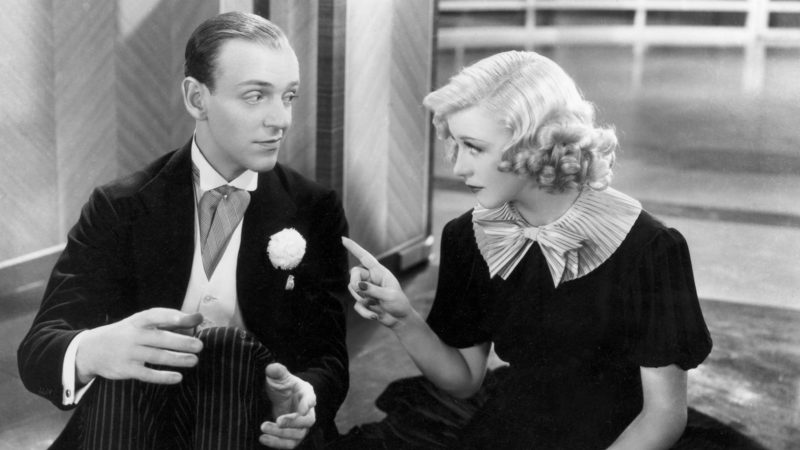
Swing Time
Plot Structures
The Astaire-Rogers plot structure par excellence, privileged above all others by its recurrence through the series, is the double love story. At the center of the film is the ideal romantic couple; a secondary, more lightweight or comic couple serves as foil. The device goes far back through our culture. It becomes especially elaborate and complex in Shakespeare’s comedies, where there are usually more than two couples, and where romantic love, though never ultimately rejected, is subjected to irony and criticism (The Merchant of Venice, Twelfth Night, As You Like It).
The structure is particularly clear in certain Mozart operas. Il Seraglio supplies us with a pair of serious lovers in the master-class (Costanze and Belmonte) and a lightweight, less serious but resourceful and resilient pair who are their respective servants, Blonde and Pedrillo. The Magic Flute contrasts the “spiritual” Tamino and Pamina (capable of initiation into transcendental mysteries) with the “earthy” Papageno and Papagena (whose ambitions end at the level of copulation and procreation).
In both operas, neither pair of lovers is seriously criticized—the serious pair command our respect, the comic pair our indulgent affection. The juxtaposition enables us to identify, freely if ambivalently, with both. Our aspirations to being beautiful, perfect people (as defined by ideology) are juxtaposed with our knowledge that we are no such thing; we can be spiritual and earthy, ideal and realistic, both at the same time. The coexistence of the second couple never seriously undermines the stature of the first: it rather reinforces it. The comic lovers are devoted to the interests of the romantic lovers, and something of the latter’s glory rubs off on them.
The key to the Astaire-Rogers image is perhaps that, in the early phase of their joint career (lingering on even into Follow the Fleet), there was doubt as to whether they constituted the romantic couple or the secondary couple (in both Roberta and Follow the Fleet they are the less serious lovers). What that doubt speaks for is the fusion of ordinariness and romance that defines them.
Ideological
I want now to consider a single number from Swing Time (and that not even a dance number): “The Way You Look Tonight.” The whole mythic complex that Astaire and Rogers embody is adequately represented by that scene—always provided one doesn’t lose sight of the extension given to that complex by dance.
First, we must note in passing—though this is secondary and almost incidental—that we have here a cinema shot through with racism and sexism.
Racism: The end of the number leads straight into an alternative public rendering of the song by Ricardo, the bandleader who is also in love with Rogers. The false, phony, smarmy, publicly displayed romanticism of Ricardo is contrasted with the “genuine” romanticism of Astaire—the latter carrying multiple connotations of casualness, everydayness, lack of affectation, the ordinary guy in love with the ordinary gal. In other words, the signifiers of democratic Americanness are set against the signifiers of an oily, insincere, and vaguely effeminate foreignness. In several of the films (Top Hat is the extreme case), Astaire’s genuinely feminine qualities (grace, delicacy, slender physique) are offset by a heavily emphasized effeminacy (campy mannerisms) in his rival. (I use the word “feminine” here to signify those qualities which our culture misguidedly regards as more appropriate to women than to men, and “effeminacy” to signify the affection of such qualities).
Sexism: Beyond almost any other Hollywood team, Astaire and Rogers appear to express male-female equality, a balanced interdependence. But even here the equality is more apparent than real: one habitually speaks of Rogers as Astaire’s partner, rather than the other way round, which neatly sums up the ambiguity of the term “partnership” here. The plot of Swing Time has Rogers perpetually at the mercy of the dominant male: the policeman, her boss at the dancing academy, Ricardo. At the denouement she is helpless to bring about the right, preordained ending: it is Astaire who prevents her from marrying Ricardo. “The Way You Look Tonight” could only be sung by a man (unless by that supreme cultural transgressor, Billie Holiday). “Look” is the passive verb (= appear); the active “look” is the prerogative of the male, objectifying women (even if, as here, only in imagination—Astaire’s fantasy image of Rogers is humorously contrasted with her actual appearance at that moment).
In theory, American democracy means equality for all; on the level of ideology, this translates into “equality for all white American heterosexual males.” To raise these issues, it is only fair to add, is scarcely to make a specific criticism of Swing Time, which simply partakes unreflectingly of general characteristics of its culture. Nonetheless, these characteristics are clearly an aspect of the film’s functioning, hence demand notice.
The fusion of ordinariness and romance is perhaps most succinctly epitomized in the play with the shampoo. As Astaire sings at the piano to his ideal image, Rogers is in fact washing her hair, in the course of which action she is gradually seduced into listening, reacting, then moving toward Astaire, who turns to confront his ideal image and sees a girl with shampoo all over her head. What we have here is a fairly complex variant on a phenomenon central to the functioning of the star system, with its equivocal fantasy identification: the woman on the screen is both a simple working girl (“just like us”) and a glamorous movie star (Jean Arthur, Margaret Sullavan, Ginger Rogers). Ginger with shampoo on her hair—signaled within the diegesis as ordinary, homely, caught in a humiliating position—is in fact at her most glamorous and goddess-like, the stiffening effect of the shampoo converting her almost into a statue. One has only to adduce Claude Levi-Strauss’ perception that the essential function of myth is to reconcile (or to seem to reconcile) fundamental contradictions within the culture.
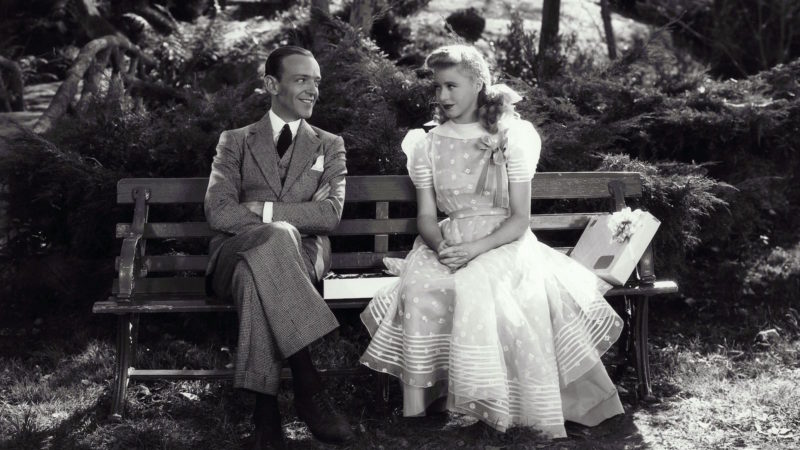
The Story of Vernon and Irene Castle
“Never, never change”: the song’s key line, and the key to the satisfactions offered by the Astaire-Rogers movies. The entire concept of romantic love is centered on the condition of unchangingness (if not, as here, literal physical unchangingness, then at least emotional permanence). Even while it celebrates this, the song implicitly registers its impossibility, taking a transient, indeed an imaginary moment— “Just the way you look tonight…With each word your tenderness grows…That laugh that wrinkles your nose….”—and assuming it can somehow be made immortal: “Won’t you please arrange it ‘cause I love you?”
In fact, two totally irrational assumptions underlie the concept of romantic love, both of them directly relevant to the Astaire-Rogers films. One is that, somewhere in the world, there is the one right, perfect partner made for you—as opposed to several million possible relationships, all of which might be equally satisfactory or unsatisfactory, or a number of people one might love simultaneously. This myth is the foundation for the entire Astaire-Rogers partnership. The audience knows from before the start, as a given, that they will end up together; anything else is unthinkable. The film can then take the relationship for granted, as it no longer has to be explained or given any psychological foundation; by Swing Time, the endless teasings and frustrations of the plotline have become a kind of ritual. The power of this myth also makes acceptable what we otherwise might find monstrous. Transposed into real life, the machinations of Astaire’s fellow dancers to prevent his marriage (in the opening of Swing Time) would appear callous in the extreme. As soon as the cut-in shot of the bride tells us that she isn’t Rogers, everything is all right—of course he can’t marry her, and any device that prevents it is legitimate.
The other irrational assumption is this: the romantic couple relationship must never be thought of as susceptible to change. One of the traditional ways out of the narrative problem that arises from this is to have the couple die (the “star-crossed lovers” syndrome). The other way is to simply end the narrative with the couple together but not quite (or only just) married—suspended at the moment of perfection, which, as it is given no sequel, becomes eternal.
Ideal romantic love can’t be shown to continue into marriage. If it does, it is transformed into the alternative pillar of our sexual ideology, the Family, habitually presented as in conflict with romance. One might sum up the problem confronting the Astaire-Rogers scriptwriters as: How to keep Fred and Ginger from getting married for between ninety and one hundred minutes of screen time? The Story of Vernon and Irene Castle is instructive here, the significance being that it was never very popular and is now the least frequently revived of the whole RKO series. Its first part is absolutely in line with the previous films: Ginger can’t or won’t dance with Fred until he buys her a Dutch cap (a plot device that has particular, if presumably accidental, felicity in Britain, where Dutch cap is a slang phrase for female contraceptives). With that resolved relatively early, the film breaks the crucial rules. They get married, and Fred gets killed. The other film that was never popular and is rarely revived is The Barkleys of Broadway, where Astaire and Rogers are noticeably growing older. One may also adduce here the reluctance of audiences to accept Astaire’s other partners after the breakup: however capable and charming the girl, there was always that uneasy sense of infidelity, a tacit acknowledgement of the shakiness of the mythic foundations.
Fred and Ginger—ordinary guy and ordinary gal, subject to change, marriage, aging, death—are also Astaire and Rogers, god and goddess, who can be caught and immortalized at the perfect moment of romantic love. The tangles of the plots stand in (however trivially) for the trials, frustrations, vicissitudes of real life. It is these that the dances transcend. It is in the dances, through the extraordinary skills of Astaire and Rogers, that the transformation happens: ordinary guy, ordinary gal become god and goddess before our very eyes. And so one is actually grateful for, and touched by, the one flaw in what is perhaps their supreme dance number, Swing Time’s “Never Gonna Dance”: the one cut as they reach the top of the staircase that, in undermining the single-take law of Astaire’s choreography, suggests that the god and goddess couldn’t quite make it, that they are human after all.
Dance in the Astaire-Rogers films signifies fulfillment, transcendence, and perfect union. Swing Time plays in a very sophisticated way on the knowledge that what audiences want to see is the fulfillment of the myth of romantic love, Astaire and Rogers dancing together. We are kept waiting for the first dance almost as long as Hitchcock kept us waiting for the first bird attack; when at last they are on a dance floor together, we have to go through the agony of watching Astaire pretend he can’t dance; all the middle part of the film is occupied with Ricardo’s efforts to make dancing together impossible; the climactic dance is preceded, at length, by the song “Never Gonna Dance.”
Dance on film is the perfect realization of the contradictions of “Never, never change”—dance, the most transient of all the arts, where every movement ends at the same time as it begins, captured and eternalized on celluloid. What we love about Astaire and Rogers is that they convince us momentarily that the ideal romantic love our culture programs us to believe in can, against all common sense, be realized.
Fred & Ginger, a complete 10-film retrospective, begins Friday, July 13 at the Film Society of Lincoln Center.



